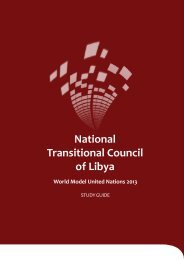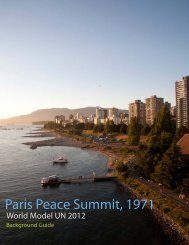Disarmament and International Security Committee (DISEC)World ...
Disarmament and International Security Committee (DISEC)World ...
Disarmament and International Security Committee (DISEC)World ...
Create successful ePaper yourself
Turn your PDF publications into a flip-book with our unique Google optimized e-Paper software.
major crises occurred in 1978. During this time, China<br />
<strong>and</strong> Japan were negotiating the terms of the Treaty<br />
of Peace <strong>and</strong> Friendship. The Diaoyu/Senkaku issue<br />
became a major sticking point in the negotiations.<br />
A group of politicians from the Liberal Democratic<br />
Party in Japan sought to block all other provisions<br />
of the treaty until the Diaoyu/Senkaku provision was<br />
resolved first. The Chinese insisted that the Diaoyu/<br />
Senkaku dispute be left out of negotiations. Under the<br />
implicit encouragement of Japanese nationalists, the<br />
Japanese right-wing political group Nihon Seinensha<br />
(Japanese Youth Federation) erected a lighthouse<br />
on the Diaoyu Isl<strong>and</strong> in order to legitimize Japanese<br />
claims over the area. In response, the Chinese<br />
government sent a flotilla of fishing ships to surround<br />
the isl<strong>and</strong> <strong>and</strong> insisted. The Japanese government has<br />
regularly sent its Maritime <strong>Security</strong> Forces, namely its<br />
naval forces, to remove Chinese fishermen from the<br />
area. After a week of st<strong>and</strong>off, Japan agreed to table<br />
discussion of the dispute. the Chinese withdrew the<br />
vessels. In October 1878, the treaty was signed in<br />
Beijing. Both the Chinese <strong>and</strong> Japanese governments<br />
decided to shelve the issue for the future. 35<br />
More unilateral declarations <strong>and</strong> corresponding<br />
protests from the opposing side took place during the<br />
1990s. In 1992, China re-asserted its claim by passing<br />
the Law on the Territorial Sea <strong>and</strong> Contiguous Zone,<br />
which explicitly specified that the Diaoyu Isl<strong>and</strong>s was<br />
China’s territory. In 1996, Japan declared an Exclusive<br />
Economic Zone around the Diaoyu/Senkaku Isl<strong>and</strong>s.<br />
Case Study: The Arctic Circle<br />
in recent decades, the Arctic climate has changed<br />
more dramatically than that of any other area of the<br />
world. 36 For example, Alaska’s average temperature<br />
increased by 4.9 degrees Fahrenheit since 1950<br />
compared to a 1.8 degrees increase in the rest of the<br />
U.S. More frozen areas of the Arctic sea melted in 2007<br />
than in any other year on record. In 2007, Arctic sea<br />
ice during the melting season dropped to the lowest<br />
levels since satellite measurements began keeping<br />
track of melting patterns in 1979. In September,<br />
the average sea ice extent was 4.28 million square<br />
kilometers, which was the lowest September on<br />
record. This broke the previous record for the month<br />
set in 2005 by 23 percent, suggesting the acceleration<br />
of the rate of sea ice melting. 37<br />
the melting of the ice has strategic implications<br />
as well as a significant impact on the ecosystem.<br />
The shrinking ice sheets have reduced the home<br />
<strong>and</strong> feeding areas of polar bears, resulting in their<br />
designation as a threatened species. The lives of the<br />
indigenous Arctic people are also negatively affected.<br />
The melting has had significant economic impacts<br />
as well. Shrinking ice caps allow easier extraction of<br />
oil, gas, <strong>and</strong> minerals under the ocean floor. Warmer<br />
weather also allows for more agriculture.<br />
in the past, sea ice was deep across the pole.<br />
Countries could not access much of the Arctic Sea <strong>and</strong><br />
thus claims to regions had no real economic value.<br />
thus, countries in the latter half of the 20th century<br />
did not seek to find a framework to replace the sector<br />
principle. 38 Consequently, countries worked through<br />
the 1990s to establish a formal legal framework for<br />
making sovereign claims over the Arctic Seabed. The<br />
result was the united Nations Conference on the Law<br />
of the Sea treaty.<br />
Under the UN Convention on the Law of the<br />
Sea (UNCLOS), the United States, Russia, Canada,<br />
Norway, <strong>and</strong> Denmark are the only countries<br />
permitted to submit bids for Arctic territory. The<br />
process began in spring of 2012 <strong>and</strong> is expected to<br />
end in 2014. the successful applicants will then gain<br />
resource exploration rights. 39<br />
Under the Convention on the Law of the Sea,<br />
countries can acquire rights to seafloor territory if the<br />
areas are linked to their continental shelves. However,<br />
like the Kyoto <strong>and</strong> other treaties, different nations<br />
have various levels of commitment to the Law of the<br />
14<br />
Melbourne Host Directorate PTY LTD | Office of Media <strong>and</strong> Design
















